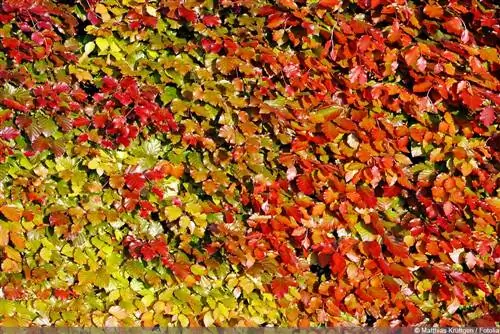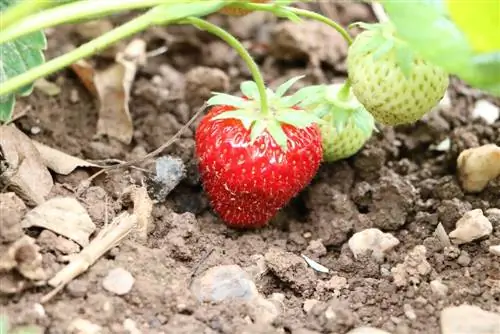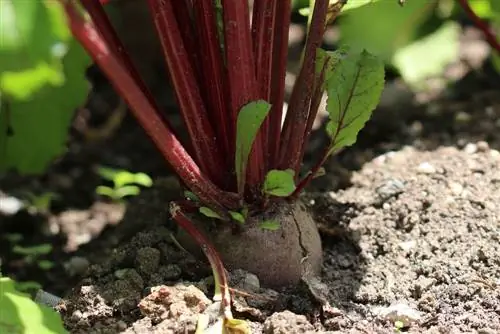- Author admin [email protected].
- Public 2023-12-17 03:39.
- Last modified 2025-01-24 12:45.
In the summer, reeds grow surprisingly well and that is usually desired. The long stalks quickly form a dense, green oasis made of countless leaves. This plant is the ideal plant for the bank of a pond. Is it necessary to use scissors to tame this growth? And what about the dried out plant parts in autumn? Does it then need to be cut?
Is cutting good for the reeds?
Reeds can quickly spread uncontrollably, conquering every available centimeter and even threatening neighboring plants. If it is not kept under control in time through courageous pruning measures, its volume can increase explosively in a short time. Trimming the reeds back to an acceptable shape is a laborious undertaking. For many types of reeds, all parts above ground dry out completely in autumn. Every gardening year starts with new, fresh shoots. Everything that has dried up must be consecrated to make way for new growth. For the optimal growth of the reed plant, suitable pruning measures are an integral part of the care.
Is timing important?
Over the course of a gardening year, there are always times when reaching for secateurs seems obvious. For example in autumn, when the stalks and leaves turn yellow-brown and dry completely. What's the point of them sticking around now? None, many gardeners say to themselves and cut everything off. Just like you are used to with many other plants. But this is fundamentally wrong with reeds and can even harm them significantly. Even in the event that the overgrown green reeds develop too lushly for the gardener's taste, patience should be exercised as much as possible until the appropriate time has come.
Pruning is allowed in spring
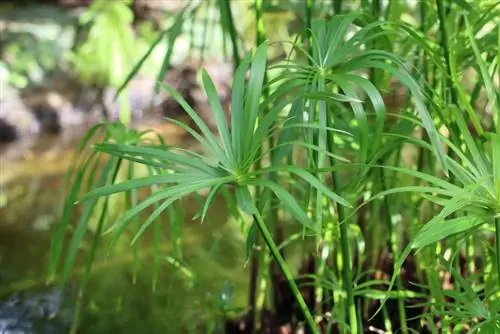
Spring is the only time of year that is optimal for cutting reeds, regardless of which of the different varieties are involved. One variety is cut a little earlier, the other a little later, but always in spring.
- Spring is optimal
- and the only suitable period
- exact timing depends on the variety
- oriented towards the beginning of growth
- Pruning should be done immediately before new growth
- the weather also decides the time
- After mild winters, the growing season often starts earlier
- the cutting time can be between the end of February and May
- The popular Chinese grass, also called miscanthus, is cut in April
Tip:
Sometimes the exact variety name and cutting time are not known. Then it helps to check the reed plant at short intervals in the spring. As soon as it sprouts again, it's high time for cutting. The time can then be saved for next year.
Why autumn and winter are not suitable
In autumn, the stalks and foliage of the reed plants change color from bright green to yellow or brown. Without sap, completely dried up, the above-ground shoots rise into the air; life has completely disappeared from them. However, the plant still needs them to get it safely through the cold season. They form a dense, protective coat that mitigates the icy winds and thus makes the plant hardy.
- leave everything dry for now
- it serves as frost protection for the plant
- Pruning in autumn increases the risk of frostbite
- hollow tubes can fill with water
- this accumulation of water promotes rot
- the reed grass is damaged
- or die completely
Incidentally, dried reeds also have a very decorative effect in the garden in winter. Especially when hoar frost covers it and the whole plant glitters in the morning light.
Note:
Some evergreen grasses are often mistakenly called reeds. Wilted and damaged shoots from these plants can be carefully removed in the fall.
Consider ecological aspects

Many densely overgrown reed plants accommodate animal guests in winter. Ladybirds and lacewings like to use the dried reeds as winter quarters because they find protection from unpleasant weather conditions. Larvae often cling to stalks of water reeds and wait for warmer temperatures to hatch. Almost all of them are useful creatures that protect the garden from pests during the summer.
- Cutting too early can disrupt the development of the animals
- check the reeds for animal inhabitants before cutting
- then it's better to wait before the cut
- only cut when the quarters have been left
- if applicable skip the cut for a year
- the reeds can easily cope with a year without cutting
How often do reeds need to be cut?
The reeds are cut once a year, always in spring. Regular annual pruning is absolutely necessary for such a growth-friendly plant in order to maintain the desired shape. The dried out plant parts also literally force annual pruning. Although they are dry, they are still extremely stable in their shape. Even in spring and summer they remain firmly attached to the plant and take up space and significantly restrict the space for new growth. The green reeds with brown splashes of color also look strange or even unhe althy.
Tip:
If the cut could not be made in time before new growth, it should not be done at a later date. A year without cutting does not harm the reeds. However, the reeds must be cut by next spring at the latest.
The right cutting tool
Cutting the reeds is an extensive and often time-consuming activity. It must be well prepared so that the execution goes smoothly. This includes the right cutting tool, which makes cutting possible in dense undergrowth.
- The circumference and density of the reeds is determined by the cutting tool
- Knives and secateurs are unsuitable for dense vegetation
- should at least have long cutting blades
- a large hedge trimmer is even better
- Pruning shears have also proven useful
- electric hedge trimmer is optimal
Note:
The cutting tool used should be sharp to leave clean cutting surfaces. It should also be cleaned and disinfected beforehand so that no pathogens are transmitted during cutting.
Protective measures during cutting
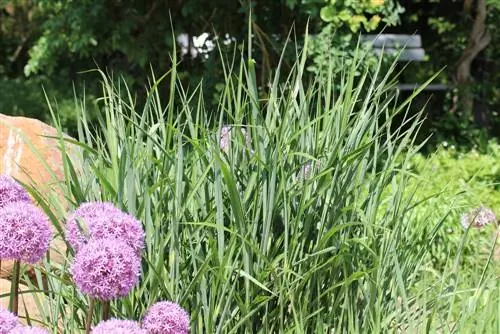
Before you start cutting, you should protect yourself from direct contact with this plant. Reed grass has sharp edges and can cause serious cuts. Since the reeds usually stick up, you should protect your whole body, but especially your hands.
- Reed grass has very sharp edges
- Cutting injuries like those with a knife are possible
- Cover all parts of the body
- Wear clothes with long sleeves
- Safety glasses protect the eyes
- " thick" gloves are a must
Tip:
There is a risk of injury not only when cutting, but also when disposing of the clippings. Therefore, keep your protective clothing until last.
And this is how we cut
Spring pruning is a radical pruning in which all above-ground parts are cut off. A large reed plant therefore requires a lot of cutting. The planned approach makes work easier.
- Have the appropriate pruning tool ready, cleaned and disinfected.
- Wear long clothing to protect yourself from cuts. Wear gloves and, if possible, safety glasses. When cutting with an electric hedge trimmer, small parts could fly through the air.
- Cut the reeds “in portions”. To do this, hold a few stalks with one hand while you cut with the other hand. However, if you cut with a hedge trimmer, you will need both hands. You can first divide the stalks into several small bunches and tie them together.
- Cut the bundled stalks close to the ground. The remaining ends should be about 10 cm high.
- Work gradually from the outside in until you have cut off all the dried stalks.
Note:
If the new shoots are already showing, the cut must be made over them so as not to injure their tips. If the new growth is already well advanced, cutting should be avoided. Alternatively, individual stalks can be carefully cut out.
Urgent cutting measures
Sometimes the robust reeds can also be affected. Incorrect location and incorrect care can trigger unsightly or even life-threatening damage.
- progressive rot
- “Sunburn damage” such as yellow and wilted leaves
- require immediate pruning measures
- even outside the optimal time
- Partial cutting: only cut affected parts of the plant
- if there is severe rot, a radical cut is essential
Note:
Take suitable protective measures against the risk of injury from sharp-edged leaves, even when making partial cuts. A suitable, cleaned and disinfected cutting tool is an important requirement, even for smaller cutting measures.
Pruning measures for heavy growth
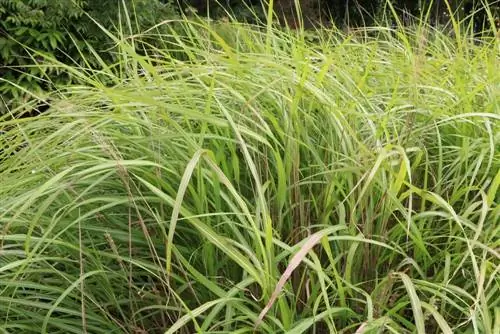
If a reed plant spreads so much that radical pruning in spring cannot control it, cutting in the root area is unavoidable. It should also be mentioned that it is best to take precautions when planting. Installing a root barrier is labor-intensive, but it reliably keeps the root area under control. If this work is neglected, the reeds will be able to spread unhindered.
- reduce the circumference of the plant
- with pickaxe or spade
- determine the desired scope
- Prick deep into the soil around it and separate the roots
- dig up the severed roots
Tip:
The separated root parts can be used for propagation. Simply plant them in the new location. This time it's best to use a root barrier.
Where do I put the cut reeds?
If you cut a full-grown reed plant, you pile up a small mountain with the cut parts of the plant. Creative people might enjoy some sturdy, hollow reeds. They are ideal for crafting, for example so-called insect hotels. But what should happen to the rest? Can the reeds be composted?
- fibrous reeds rot very slowly
- only put small amounts on the compost heap
- chopping beforehand
- the rest can go in the organic waste bin
Note:
If a diseased reed is cut, the cut material must be treated as residual waste and disposed of accordingly.


